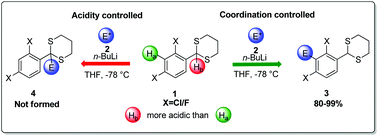The directing group wins over acidity: kinetically controlled regioselective lithiation for functionalization of 2-(2,4-dihalophenyl)-1,3-dithiane derivatives†
Abstract
Regioselective lithiation followed by functionalization of 2-(2,4-dihalophenyl)-1,3-dithiane derivatives with different electrophiles was achieved in good to excellent yields. When the title compound is treated with n-butyl lithium, lithiation occurs selectively at the aromatic carbon having less acidic proton despite the presence of thermodynamically more acidic 1,3-dithiane proton in the same molecule. Computationally calculated pKa values of the available reactive site protons and the experimental results suggest that the regioselective lithiation in 2-(2,4-dihalophenyl)-1,3-dithiane derivatives is not governed by thermodynamic acidity rather exclusively dictated by the kinetic removal of protons due to cooperative coordination (complex induced proximity effect, CIPE) and inductive effects of the 1,3-dihalo substituents present in the aromatic ring. By employing this regioselective functionalization, diverse 1,2,3,4-tetra-substituted aromatic compounds were prepared with ease.


 Please wait while we load your content...
Please wait while we load your content...